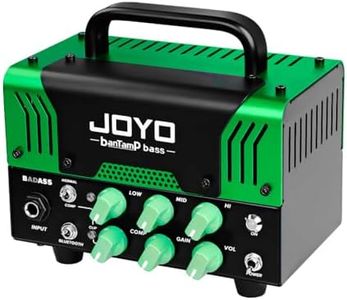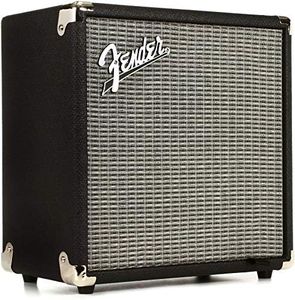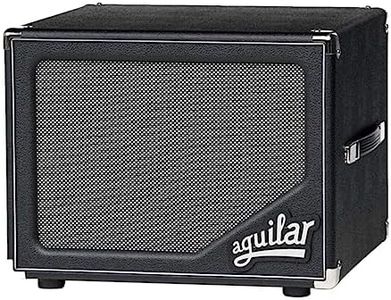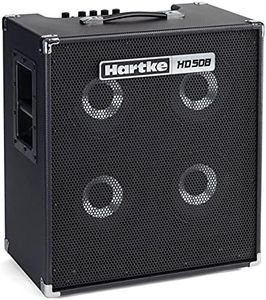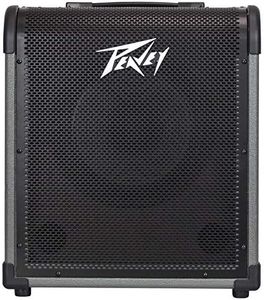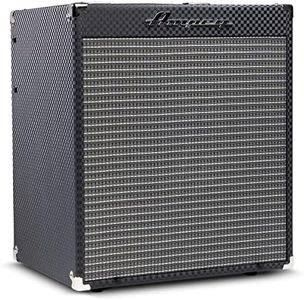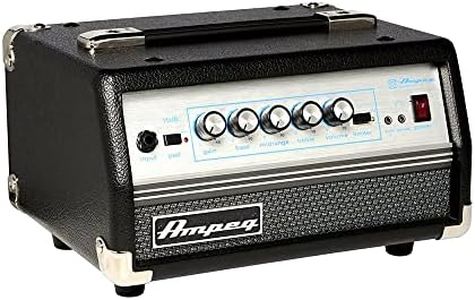10 Best Bass Guitar Amplifiers 2025 in the United States
Our technology thoroughly searches through the online shopping world, reviewing hundreds of sites. We then process and analyze this information, updating in real-time to bring you the latest top-rated products. This way, you always get the best and most current options available.

Our Top Picks
Winner
Fender Rumble 25 V3 Bass Amplifier, Bass Combo Amp, 25 Watts, with 2-Year Warranty, 8 Inch Speaker, with Overdrive Circuit and Mid-Scoop Contour Switch
Most important from
7519 reviews
The Fender Rumble 25 V3 is a compact and solidly built bass combo amp, perfect for beginners or those needing a practice amp. It offers 25 watts of power paired with an 8-inch speaker, which provides enough volume and deep bass tones for home use or small jam sessions. The amp includes useful tone controls like a mid-scoop contour switch and an overdrive circuit that lets you explore a range of sounds, from gritty and growling to modern punchy bass. This flexibility is a real plus for players wanting to experiment with their tone without extra gear.
It also features practical inputs such as a headphone jack for silent practice and an auxiliary input to jam along with music from your phone or MP3 player. Weighing about 18 pounds and with moderate size, it’s fairly portable but not the lightest option on the market. While it doesn’t have a wide variety of built-in effects beyond overdrive, its simple layout and solid construction make it reliable and user-friendly.
If you’re looking for a budget-friendly, versatile amp mainly for practice or small gatherings, the Fender Rumble 25 V3 is a strong contender. Those needing more power, bigger speakers, or advanced effects might eventually outgrow it.
Most important from
7519 reviews
Ampeg Venture V7 Bass Guitar Head, 700 Watts
The Ampeg Venture V7 Bass Guitar Head is a powerful amplifier with 700 watts, making it suitable for both practice and live performances. Its compact design (18 x 13 x 5 inches) and lightweight build (7 pounds) make it highly portable, which is great for musicians on the go.
The legacy preamp with a 3-band EQ and sweepable mids offers detailed tone control, allowing you to dial in the perfect sound for your bass guitar. Additionally, the Ultra Hi/3-way Ultra Lo switches provide versatile tonal options, catering to different musical styles and preferences. The footswitchable SGT Overdrive circuit, with SVT and B15 voicing switch, adds a layer of flexibility, enabling you to switch between clean and overdriven tones seamlessly during a performance.
The effects loop, XLR DI output, Aux input, and headphone output offer a variety of connectivity options, making it versatile for different setups. The dual Neutrik speakON outputs ensure a secure connection to your speakers. On the downside, the amp is corded electric, which may limit placement flexibility on stage or in practice spaces. The Ampeg Venture V7 offers a strong combination of power, portability, and tone control features, making it a reliable choice for bass players seeking a high-performance amplifier.
Ampeg Venture V12 Bass Guitar Head, 1200 Watts
The Ampeg Venture V12 Bass Guitar Head stands out in the bass-guitar-amplifiers category with its impressive 1200-watt power output, making it suitable for both practice sessions and live performances in larger venues. Weighing only 11 pounds and featuring compact dimensions (21 x 14 x 5 inches), this amplifier is highly portable, ideal for musicians on the go.
The legacy preamp with a 3-band EQ allows for versatile tone control, while the sweepable mids and Ultra Hi/3-way Ultra Lo switches provide additional sound shaping options. The footswitchable SGT overdrive circuit with SVT and B15 voicing switch, along with an onboard variable compressor, offers a range of built-in effects for enhancing your bass sound. The inclusion of an effects loop, XLR DI output, aux input, and phones output ensures versatility in connectivity and usability in various settings.
The dual Neutrik speakON output enhances compatibility with different speaker cabinets. One drawback might be the lack of a built-in speaker, meaning you'll need an external cabinet for sound output. The Ampeg Venture V12 is a powerful and feature-rich option for bass players who need both portability and extensive tone shaping capabilities.
Buying Guide for the Best Bass Guitar Amplifiers
Choosing the right bass guitar amplifier is crucial for achieving the sound you desire and ensuring your instrument's tone is properly amplified. Whether you're playing at home, in a studio, or on stage, the right amp can make a significant difference in your performance. To make an informed decision, it's important to understand the key specifications and how they align with your needs and playing style.FAQ
Most Popular Categories Right Now
